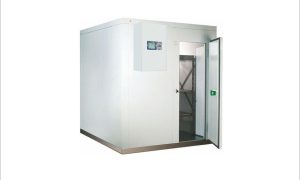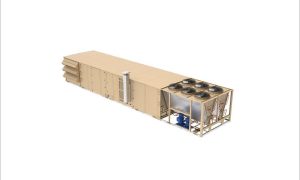The vital challenges faced by the Indian cold storage industry include space constraints, technological advancements, and evolving scenarios. With India’s position as the world’s largest producer of milk and the second-largest producer of fruits and vegetables, there is a growing demand for robust and efficient cold storage management across various sectors.
India’s cold storage industry is witnessing a significant transformation driven by changing demands and technological advancements. The shift towards multi-commodity models and innovative chilling options is reshaping the industry. India’s cold storage industry, traditionally developed for bulk products like onions and potatoes, is undergoing a significant transformation. With India’s position as the world’s largest producer of milk and the second-largest producer of fruits and vegetables, there is a growing demand for robust and efficient cold storage management across various sectors. Farmers are increasingly shifting towards cultivating fruits and vegetables due to increased risks and investments in grain crops. This shift has led to a surge in demand for specialised cold storage facilities such as mushroom chambers, ripening facilities, and apple-controlled atmosphere storage. This transition towards multi-commodity models ensures better investment return and enables year-round plant operation.
Technological advancements
Over the past few decades, the cold storage industry has witnessed significant technological upgrades globally. According to reports, the global Cold Storage Warehouse market is projected to grow significantly, reaching US$ 331.5 billion by 2031 at a CAGR of 12 per cent from 2023 to 2031. High-energy-efficient refrigeration systems with superior performance and thermal insulation have revolutionised the industry, says Mukesh Aggarwal, General Secretary of the Federation of Cold Storage Association of India. Within the cold storage sector, two types of distinct segments exist. The first segment comprises traditional cold stores primarily used for commodities like potatoes. According to Vikas Choudaha, Senior Vice President & Business Head at Godrej Storage Solutions, there is a growing potential for cold chain logistics and warehousing in the food industry, particularly in seafood, meat, and poultry. The second aspect pertains to specific regions with seasonal demands for cold storage. Establishing and maintaining cold storage for short durations poses unique challenges.
Innovations and cold chain strategies to meet growth in demand
Innovation plays a crucial role in meeting the evolving demands of the cold storage industry. Various segments, including the seafood and dairy industries, require advanced chilling options. For instance, the seafood industry may necessitate no-contact freezers, while the dairy industry relies on high-capacity blast freezers. Also, the refrigeration industry holds the prerogative to develop new and innovative products that cater to these specific needs. Furthermore, there is a strong emphasis on optimising the cold chain process for perishable goods, encompassing storage, logistics, and transhipment points. Inadequate handling during transportation or at intermediate points in the supply chain can lead to wastage, prompting the use of large-sized trucks to ensure proper care during transit.
Companies are actively exploring design strategies for cold storage warehouses to reduce refrigeration load and enhance energy efficiency. Rather than creating separate cold rooms within the warehouse, the focus is shifting towards constructing the entire warehouse with double walls for insulation. This approach and the construction of taller warehouses help mitigate heat load and improve refrigeration efficiency.
While the growth in the cold storage industry is promising, significant parts of India still need access to cold chain infrastructure. Rajat Gupta, Founder & CEO of TESSOL, highlights the importance of government policies, infrastructure development, innovation, and profitability in encouraging more players to enter the cold chain business. Additionally, increasing demand for transparency and traceability in the supply chain drives the need for enhanced cold storage facilities.
Energy storage
In the cold storage industry, energy storage solutions, including batteries, are gaining traction, as they offer a reliable backup during power outages. Cold warehouses, which account for 70 per cent of total requirements, heavily rely on cooling systems, resulting in cooling consuming 80 per cent of total electricity consumption. By utilising energy storage technologies, such as batteries, businesses can reduce their dependence on traditional power sources like backup generators and diesel generators. Storing cooling or electricity, when available at a lower cost, becomes an attractive option, especially when electricity prices are high or unavailable. Vishnu Sasidharan, Vice President of Climate Technologies at Pluss Advanced Technologies, highlights that energy storage is a cost-effective solution for these scenarios. On the other hand, Swarup Bose, Founder & CEO of Celcius Technologies, emphasises the potential of solar power as a sustainable energy source for cold storage, reducing carbon footprints significantly. Solar panels on the warehouse roof and surrounding areas can wholly or partially fulfil the energy requirements of cold storage facilities.
PCM and temperature control
Traditionally, maintaining a consistent temperature throughout the storage space has been the norm. However, in taller warehouses, a more sophisticated approach is being adopted. Temperature mapping using strategically placed sensors across storage rack systems allows for precise temperature control and the prevention of localised hot spots or variations. Phase change materials (PCMs) are being integrated into cold storage and building HVAC systems, providing consistent temperature control without the need for compressors to run for extended periods. PCM technology allows conventional freezers to be turned off completely, resulting in energy efficiency by reducing compressor runtime. Insulating the freezer and utilising PCMs significantly enhances thermal efficiency, leading to a compressor frequency reduction of up to 20 to 30 per cent. This implementation of PCMs in refrigeration systems offers a significant advantage in terms of energy savings.
By integrating controls, the cooling system can be optimised for energy efficiency. Arvinder Pental, VP & Head – Commercial Refrigeration, Voltas says, in reality, the controls enable intelligent operations, including advanced algorithms and sensors that adjust cooling output based on real-time data. This helps to minimise energy consumption, reducing operational costs and environmental impact.
Overcoming challenges
Energy efficiency remains a primary concern, and the scarcity of large land parcels in developed areas poses challenges for expanding cold storage facilities. Mukesh emphasises the challenges the cold storage industry faces, including energy efficiency, space constraints, and the need for multiple temperature zones. To overcome these hurdles, logistics hubs must be developed on the outskirts or in remote locations outside the city. Despite energy efficiency and limited space challenges, there is a growing focus on optimising the cold chain process and developing efficient warehouse designs. Bridging gaps in cold chain infrastructure and meeting the increasing demand for transparency and traceability are crucial for sustaining the industry’s growth.
Integration and automation for efficiency
To optimise temperature control and eliminate inefficiencies, warehouses increasingly integrate their operations with manufacturing or supply. Automated storage and retrieval systems enable precise temperature control, with most storage operations occurring in the back end while human operators handle inbound and outbound areas. Seamless integration and automation, utilising conveyors and other technologies, are pursued from the processing area to storage, improving overall efficiency.
Mobile racking systems have become popular in temperature-controlled warehouses in moderate and sub-zero environments. Industries such as milk, dairy, and pharmaceuticals have embraced this technology for its numerous benefits. Purpose-built solutions, designed in collaboration with experts and consultants, prioritise storage and handling in the cold storage sector.
Future advancements
Embracing environmentally friendly cooling systems becomes crucial in the pursuit of sustainable practices. With increasing environmental concerns, the choice of cooling systems becomes crucial. Using HFC refrigerants, compressor-based refrigeration poses energy challenges and contributes to global warming. As the phase-down of HCFC refrigerants has begun and HFO refrigerants are on the rise, cooling systems should meet the highest and steady demand with optimal energy efficiency. Freon systems are preferred over ammonia systems as they offer better cooling capabilities.
The cold storage industry is witnessing a transformative shift driven by advancements in energy storage, innovative temperature control approaches, integration, and automation. Implementing phase change materials enhances energy efficiency and precise temperature control in refrigeration systems. Integration and automation optimise warehouse operations, while mobile racking systems provide improved storage capabilities. By adopting these advancements, the cold storage industry is poised for enhanced efficiency, reduced energy consumption, and minimised environmental impact to meet the evolving needs of diverse sectors and ensure efficient management of perishable goods.
Swarup Bose, Founder & CEO of Celcius Technologies
“Solar panels on the warehouse roof and surrounding areas can wholly or partially fulfil the energy requirements of cold storage facilities.”
Rajat Gupta, Founder & CEO, TESSOL.
“AI will lead the way for automated temperature management as frequent deliveries require adjusting the temperature based on the product type and weather.”
Arvinder Pental, VP & Head – Commercial Refrigeration, Voltas Limited.
“Cold storage facilities play a crucial role in maintaining the quality and safety of perishable items, reducing food waste and ensuring the uninterrupted supply chain of goods.”
Mukesh Aggarwal, General Secretary, Federation of Cold Storage Association of India.
“Globally, high energy-efficient refrigeration is available with excellent performance and thermal insulations, which has changed the industry’s landscape.”
Vishnu Sasidharan, Vice President, Climate Technologies, Pluss Advanced Technologies.
“The ability to store cooling or electricity when it is available at a lower cost is one of the most cost-effective storage options when electricity is expensive or unavailable.”
Vikas Choudaha, Senior Vice President & Business Head, Godrej Storage Solutions, Godrej & Boyce Mfg. Co. Ltd.
“The milk, dairy and pharmaceutical industries are embracing mobile racking systems in temperature-controlled warehouses in moderate and sub-zero environments.”
Cookie Consent
We use cookies to personalize your experience. By continuing to visit this website you agree to our Terms & Conditions, Privacy Policy and Cookie Policy.















